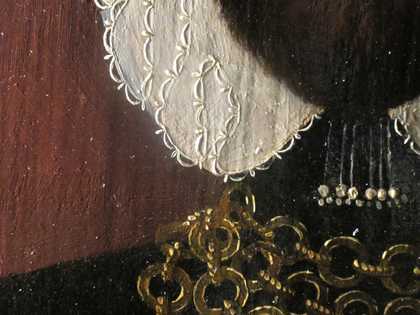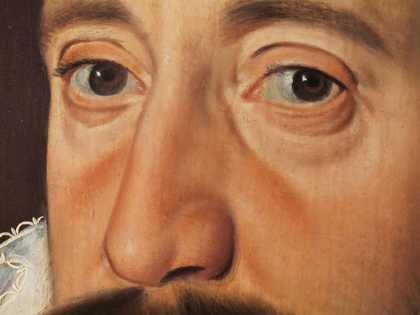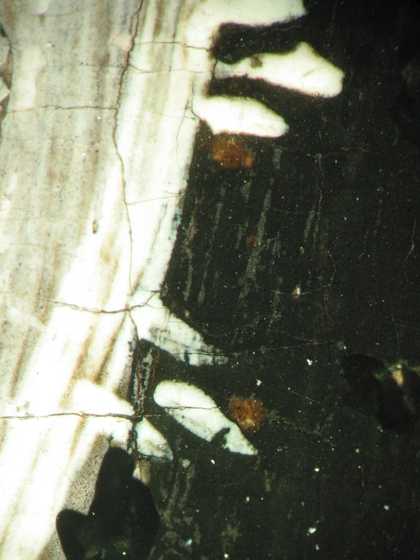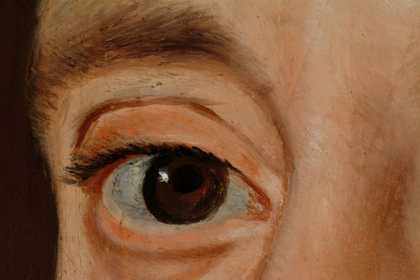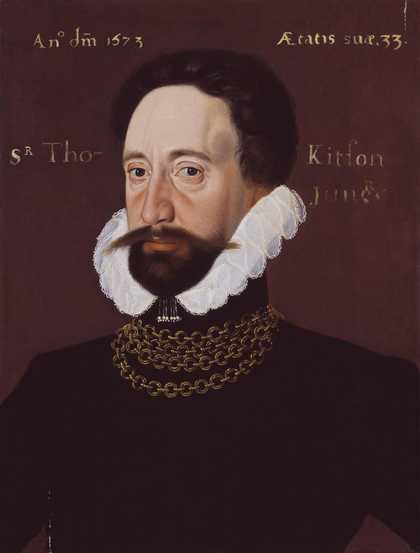
Fig.1
George Gower c.1540–1596
Sir Thomas Kytson
1573
Oil paint on panel
527 x 400 mm
N06090
This painting is in oil paint on an oak panel measuring 527 x 400 mm. The support is composed of three oak boards placed vertically and glued together at butt joins (fig.2). The X-radiograph also reveals two dowels inset into the wood on each join to hold the boards in place till the glue set. The widest board, which contains the face and central part of the body, is 240 mm across. It is flanked by boards respectively 110 mm wide on the right and 55 mm wide on the left. From comparison with Gower’s portrait of Sir Thomas’s wife, Elizabeth, Lady Kytson (Tate N06091), it would appear that the dimensions of Lord Kytson’s portrait have been reduced at some point, though this is not certain, as none of the inscriptions in the background have been truncated. Dendrochronology revealed that the left and central boards are of Baltic oak cut from the same tree, felled not earlier than 1562; no results could be obtained for the narrow right board.1 There is a permanent, slight, forward bow across the front of the panel. Both joints have suffered splitting in the past, mainly in the lower half of the painting. All splits have been rejoined and there is a reinforcing button at the bottom of the right hand joint.
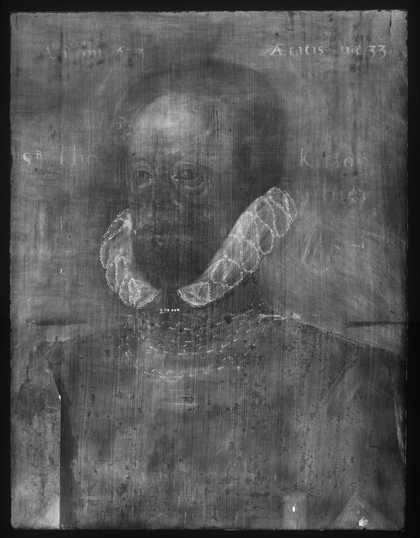
Fig.2
X-radiograph of Sir Thomas Kytson
The ground is a thick application of white marine chalk bound in animal glue. It has suffered extensive losses in the black doublet but in the upper half of the painting it is in good condition. The thin, greyish white priming is composed of lead white with black particles, bound together in oil. Inspection with infra-red reflectography indicates that it was applied streakily (fig.3).
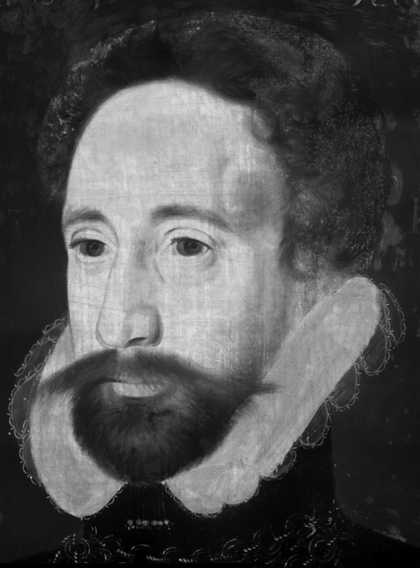
Fig.3
Infra-red detail of the face, showing firm linear underdrawing and something of the streakily applied grey priming
Infra-red reflectography (fig.3) also reveals very fine, firm, linear drawing lying beneath the paint of the face. The drawing was done on top of the priming and describes outlines rather than areas of shading; it marks out the shape and position of the features. It appears to have been done with a dry carbon point and the single, unbroken lines do not look freehand; perhaps they were transferred from a drawing that had been done from life. The iris and pupil of both eyes were originally placed in the centre of the eye, looking to the sitter’s right, and this early position is now visible as a dark pentimento at the side of the final, painted irises, which look directly at the viewer.
Generally the paint is opaque with an enamel-like surface and little discernible brushwork except in the background. Final details such as the lace trim on the ruff and the links of the gold chain were applied in thixotropic paint that has slight impasto (fig.4).2 The palette is high toned and the features of the face are defined with soft, reddish brown, linear shadows (fig.5). The artist appears to have begun the portrait by laying in the face, the ruff and the costume in thin, reddish brown oil paint, applied sketchily, especially in the face where this underpainting is confined to the shadows (fig.6). When this underpaint was dry, the visible tones of the face were applied wet-in-wet and blended together softly. The curve of eyeball was defined with a stroke of grey paint, applied wet-in-wet into the basic white and highlighted with a stroke of bright greenish blue, which probably contains azurite (fig.7).
Elsewhere he used a sequential technique with orderly layers of opaque paint, which were left to become touch dry before the next was applied. The whole of the background area was painted dark, opaque grey (fig.8). At the same time he appears to have laid in the basis of the black costume with another, slightly different dark grey. The dark grey beneath the background is composed of black (probably bone black), lead white, vermilion, red lead, yellow ochre and traces of gypsum bound in oil. That beneath the costume appears to be lamp black mixed with small amounts of red and white pigment. This was then glazed and modulated with a more translucent black mixture, based probably on bone black. The plum coloured background paint was applied on top of the dark grey and composed of a mixture of vermilion, black (probably bone), lead white and traces of ground glass. The inscriptions on top are in lead tin yellow.3
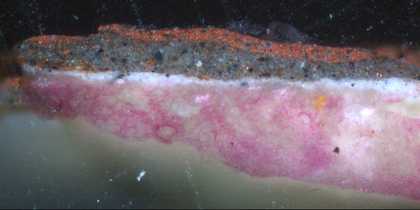
Fig.8
Cross-section through the plum coloured background. From the bottom: white ground, stained pink with Acid Fuchsin to identify the proteinaceous binding medium; thin, opaque, oil-bound, pale grey priming; dark grey underpaint; final coat of plum coloured paint
His black doublet has suffered extensive paint loss in all areas except the collar and gold chain; two phases of much later filling and repainting compensate for the damage. The medium of the original black paint fluoresces slightly when the cross-sectional samples are viewed in UV light; this suggests an oleo-resinous binder.
A significant feature of the technique that is revealed by examination of the cross-sections is the apparent use of intermediate varnishes during the course of painting. The grey underpainting in the background and costume was varnished before the next phase of painting was begun and the black costume was varnished before the detail of the gold chain was applied on top (figs.9 and 10). It would appear that Gower wanted maximum saturation of his paint, which would help ensure the high key of his colours. This feature occurs also in the companion portrait of Lady Kytson and in Gower’s Self Portrait, which is in a private collection.4
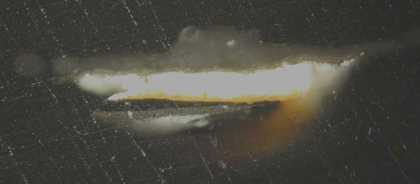
Fig.9
Cross-section through the gold chain and underlying black doublet in normal light. From the bottom: sliver of white ground; dark grey underpaint of doublet; black doublet; dark yellow of gold chain; highlight on gold chain
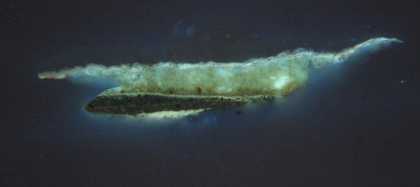
Fig.10
The same cross-section as fig.9, photographed in ultraviolet light, showing a sharp, fluorescent line of varnish between the black doublet and the gold chain. Less visible is a similar fluorescent line between the two layers making up the doublet
The painting was given full cleaning and restoration in 1995. The costume, the background and the inscriptions had been completely repainted, probably in the nineteenth century, and the varnish on top of the image had become yellow. In the restoration of 1995 most of the repainted costume was retained because x-radiography and microscopic examination revealed that the underlying original was very badly damaged indeed. Elsewhere all non-original paint was removed because the original is in good condition. Minor old damages in the original background and in the sitter’s left temple were retouched with pigment bound in modern synthetic resins.
July 2015

